[ESP/ENG] Los autos de la F1 al desnudo: Ferrari y su desafío aerodinámico con los sidepod colocados en forma opuesta a Red Bull. / Naked F1 cars: Ferrari and its aerodynamic challenge with sidepods positioned opposite to Red Bull.
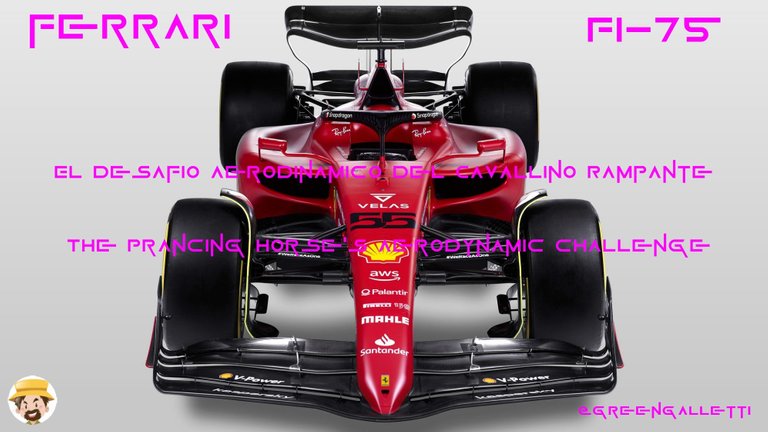
Después de haber analizado y compartido en esta Comunidad los verdaderos cambios en los equipos de Fórmula 1 para esta temporada -y no esas imágenes renderizadas que la mayoría nos hizo ver en las presentaciones oficiales (salvo Aston Martin en parte)- habíamos iniciado con el equipo que tiene a su actual campeón en el Mundial de Pilotos. Me refiero a Red Bull obviamente y a los efectos cambios introducidos en su RB18, revolucionarios en algunos casos, destacando toda la fantasía que en términos de aprovechamiento aerodinámico, puede salir de la mente de un ingeniero del calibre de Adrian Newey.
Los resultados en las sesiones de pruebas de Montmeló en Barcelona no lograron optimizar las prestaciones que el monoplaza pretendía, pero la temporada es larga y el desafío recién comienza.
Hoy me voy a ocupar de un contendiente -por así llamarlo- que es un perenne candidato a ganar cualquier mundial, ya sea de pilotos o de constructores, aunque en los últimos años haya quedado un lejos de la punta y a veces hasta del podio. Pero el sueño de reverdecer viejos laureles continúa y este año más que n unca se presenta bajo los mejores auspicios. Al menos en la opinión de sus propios pilotos y técnicos
Analicemos entonces que tiene de distinto la F1-75 si es que tenía que darle un nombre emblemático la casa de Maranello lo ha hecho. Está todo dicho en el nombre del monoplaza: el significado de F1 es redundante y el número 75 va por los años del equipo.
Dentro de pocos días exactamente el 12 de marzo de 1947, Enzo Ferrari encendió por primera vez en el establecimiento de Maranello en Italia el motor del 125 S su primer monoplaza para F1. El actual F1-75 será el auto número 68 en la historia de la famosa casa automovilística en su paso por la máxima categoría del automovilismo deportivo.
En el artículo anterior dedicado al RB18 de Red Bull había hecho una referencia al significado de la palabra sidepod, un término que sentiremos bastante seguido este año, razón por la cuál no me voy a detener demasiado a explicar lo mismo.
En cambio trataré de explicar como Ferrari ha configurado el mismo para darle una mayor carga aerodinámica.

After having analysed and shared in this Community the real changes in the Formula 1 teams for this season -and not those rendered images that most of them made us see in the official presentations (except for Aston Martin in part)- we had started with the team that has its current champion in the World Drivers' Championship. I am obviously referring to Red Bull and the effects of the changes introduced in its RB18, revolutionary in some cases, highlighting all the fantasy that, in terms of aerodynamic performance, can come out of the mind of an engineer of Adrian Newey's calibre.
The results of the Montmeló test sessions in Barcelona did not manage to optimise the performance that the car was aiming for, but the season is long and the challenge has only just begun.
Today I am going to deal with a contender - so to speak - who is a perennial candidate to win any world championship, be it drivers' or constructors', although in recent years he has been a long way off the lead and sometimes even off the podium. But the dream of greening old laurels continues and this year more than ever is presented under the best auspices. At least in the opinion of its own drivers and technicians.
Let's analyse then what is different about the F1-75 if the Maranello company had to give it an emblematic name. It's all said and done in the name of the car: the meaning of F1 is redundant and the number 75 stands for the years of the team.
In a few days exactly on 12 March 1947, Enzo Ferrari fired up the engine of the 125 S, his first F1 car, for the first time at the Maranello factory in Italy. The current F1-75 will be the 68th car in the history of the famous automobile manufacturer in the top class of motorsport.
In the previous article dedicated to Red Bull's RB18 I had made a reference to the meaning of the word sidepod, a term that we will feel quite often this year, which is why I will not dwell too much on explaining the same.
Instead I will try to explain how Ferrari has configured it to give it a higher downforce.
Un sidepod distinto al de Red Bull. / A different sidepod to Red Bull.
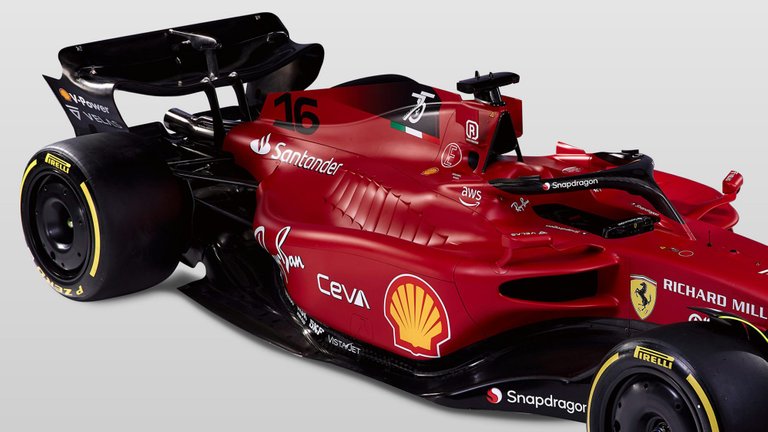
En el F1-75 los técnicos ferraristas han optado por una solución exactamente opuesta a la porpuesta por Adrián Newey en Red Buul. El frontón lateral -tratando de hispanizar la palabra sidepod-, luego de una parte inicial plana tiene una rampa ascendente donde se funde con la cubierta del motor y con una sección festoneada en esa transición, a diferencia de la rampa descendente que habíamos observado en Red Bull.
En ese sentido se parece bastante al Aston Martin, que cuenta con lamas de refrigeración en la superficie superior de las barras laterales.
Esta posición del frontón lateral y los festones hace suponen que los radiadores han sido colocados casi horizontalmente en correspondencia con los túneles de refrigeración para poder "barrer" de esta manera el aire hacia arriba más allá de las cubiertas de las levas del motor, algo similar a la disposición del Williams 2021.

In the F1-75 the Ferrari engineers have opted for a solution exactly opposite to the one proposed by Adrian Newey at Red Bull. The sidepod, after an initial flat part, has an ascending ramp where it merges with the engine cover and with a scalloped section in that transition, unlike the descending ramp we had seen in Red Bull.
In that respect it is quite similar to the Aston Martin, which has cooling louvres on the upper surface of the sidepods.
This position of the side gable and scallops suggests that the radiators have been positioned almost horizontally in correspondence with the cooling tunnels in order to "sweep" the air upwards past the engine cam covers, similar to the layout of the 2021 Williams.
El desafío aerodinámico del Cavallino Rampante. / The Prancing Horse's aerodynamic challenge.
Como ya se viene anunciando desde el año pasado por los todos medios, no solo deportivos, el cambio en el reglamento adoptado por la FIA, el llamado gran reto erodinámico -el tiempo diró si verdaderamento lo es- sigue siendo cómo maximizar la velocidad del flujo de aire hacia el suelo para que el auto tenga más "agarre", entre mejor en las curvas y salga más rápido en las rectas para decirles en palabras pobres, como si se "delizara" en la pista.
Sin embargo los resultados no han sido los esperados y el nuevo efecto porpoising del cuál también sentiremos hablar mucho en el futuro y del cuál les he hablado en este post ha deparado las primeras y desagradables sorpresas en todas esta serie de innovaciones tecnológicas.
El llamado "efecto Venturi o túnel Venturi" no es otra cosa que la aplicación del principio de Bernoulli a la F1 y al efecto suelo, con la sola diferencia que el efecto Bernoulli se aplica al agua y establece que cuando se hace pasar un líquido de forma constante por un tubo más fino en un extremo y más ancho en el otro, la velocidad a la que sale este fluido por el extremo más fino es mayor que la que sale del extremo más ancho.
La nueva reglamentación de la Fórmula 1 no ha hecho tra cosa que aplicar este principio al flujo de aire permitiendo que el aire entre por un camino ancho y salga por uno más estrecho, pero para que ello ocurra los monoplazas teben tener "faldones" laterales que atrapen el aire por debajo del monoplaza.
De ahí que la eficacia del túnel Venturi con el tamaño y forma de sus entradas determinará la fuerza del flujo de aire que además deberá ser refrigerado con una configuración diseñada especialmente en torno a este requisito aerodinámico.
A diferencia no solo de Red Bull sino también de McLaren la F1-75 de Ferrari utiliza sólo el borde de ataque superior para hacer eso y en su lugar ha ahuecado una gran zona socavada por debajo en modo si se quiere algo similar a Aston Martin dividiendo los flujos en dos partes: uno alimenta las entradas del venturi y el otro sigue los alrededores de los laterales de la carrocería.
Sin embargo la gran esperanza de Ferrari no es solo la disposición de estos flujos de aire sino la unidad de potencia que se aloja por debajo de esa cubierta del motor, permitiendo una mejor recuperación de la energía respecto al año pasado tal como la expresado públicamente el jefe de la escudería, Mattia Binotto.
Da la impresión que los alerones delanteros presentados en Montmeló no sean los reales ya que carecen de un perfil aerodinámico, sin embargo algo se puede ver: el morro tiene una pronunciada sección ahuecada por debajo que reducirá la presión del aire y este aspecto sì mejorará la carga aerodinámica.

As has been announced since last year by all media, not only sporting, the change in the regulations adopted by the FIA, the so-called great aerodynamic challenge - time will tell if it really is - is still how to maximize the speed of airflow to the ground so that the car has more "grip", enters the corners better and goes faster on the straights, to put it in poor words, as if it "slides" on the track.
However, the results have not been as expected and the new porpoising effect of which we will also feel a lot of talk in the future and of which I have spoken in this post has brought the first and unpleasant surprises in all this series of technological innovations.
The so-called "Venturi effect or Venturi tunnel" is nothing more than the application of Bernoulli's principle to F1 and the ground effect, with the only difference that the Bernoulli effect is applied to water and establishes that when a liquid is made to pass constantly through a thinner tube at one end and wider at the other, the speed at which this fluid exits the thinner end is greater than the speed at which it exits the wider end.
The new Formula 1 regulations have simply applied this principle to airflow by allowing air to enter through a wide path and exit through a narrower one, but for this to happen the cars must have side "skirts" to trap the air underneath the car.
Hence, the effectiveness of the Venturi tunnel with the size and shape of its inlets will determine the strength of the airflow, which must also be cooled with a specially designed configuration around this aerodynamic requirement.
Unlike not only Red Bull but also McLaren the Ferrari F1-75 uses only the upper leading edge to do that and instead has hollowed out a large undercut area underneath in a way if you like something similar to Aston Martin splitting the flows into two parts: one feeds the venturi inlets and the other follows around the body sides.
However, Ferrari's great hope is not only the arrangement of these airflows but the power unit which is housed underneath the engine cover, allowing better energy recovery compared to last year as publicly expressed by team boss Mattia Binotto.
It seems that the front wings presented at Montmeló are not the real thing as they lack an aerodynamic profile, but one thing can be seen: the nose has a pronounced hollowed-out section underneath which will reduce air pressure and this aspect will improve downforce.
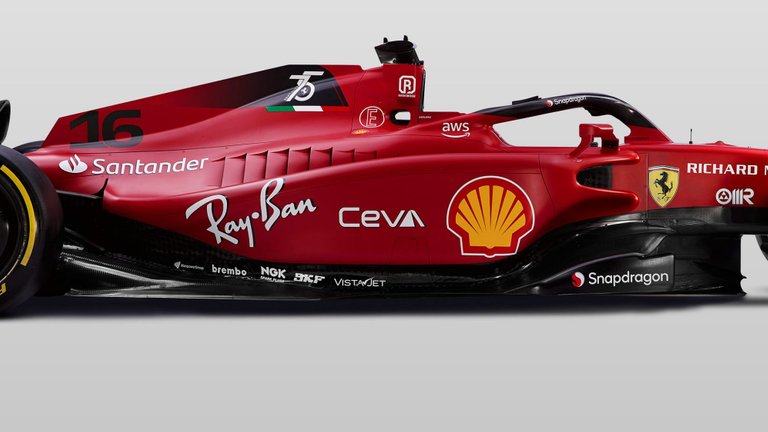

While the lateral appearance of their direct rivals is more conventional, there are other aspects that clearly differentiate them from Red Bull, which we will be looking at in the next few days.
Until then!
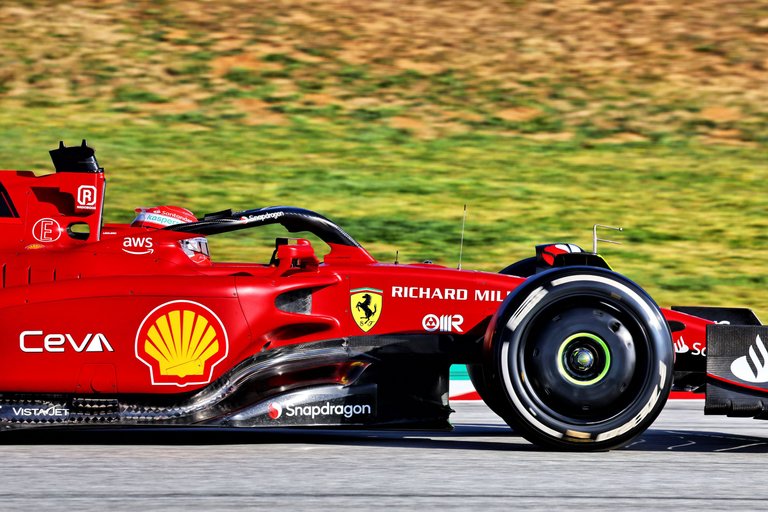
 |  | 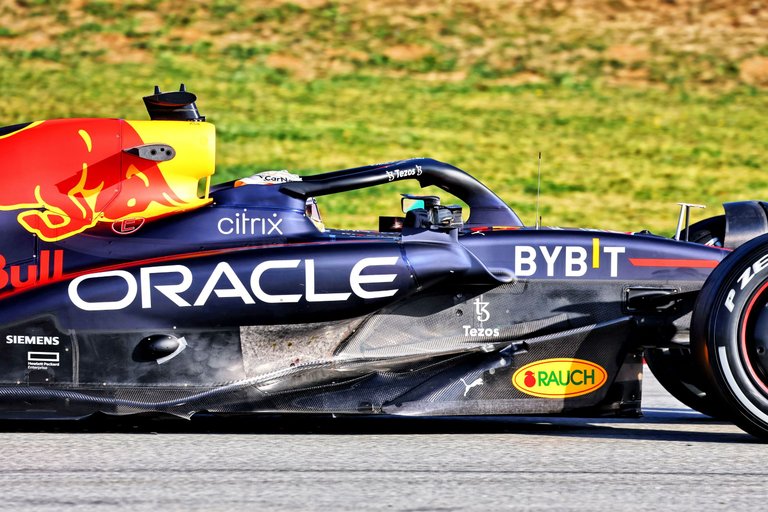 |
|---|
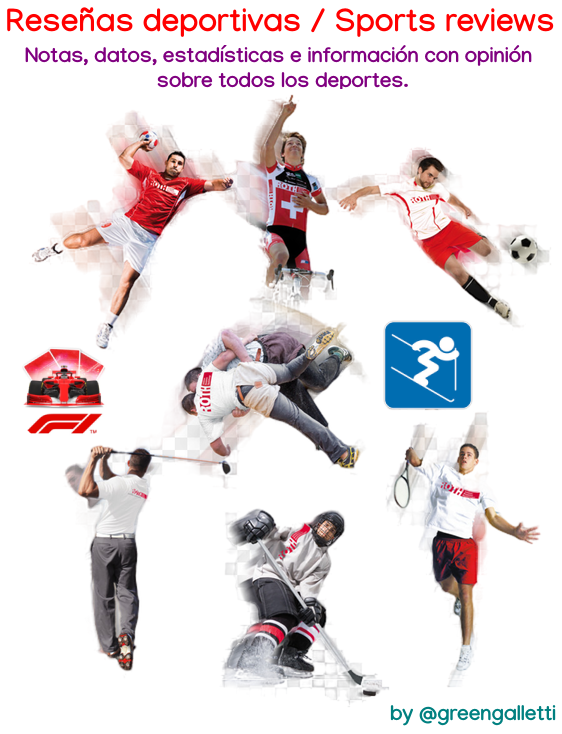

La parte inferior del banner de la firma corresponde al badget elaborado por el equipo de @hivebuzz. Mi agradecimiento a ellos y en particular a @arcange.
The lower part of the signature banner corresponds to the badget made by the @hivebuzz team. My thanks to them and in particular to @arcange.
The people doing V2K with remote neural monitoring want me to believe this lady @battleaxe is an operator. She is involved deeply with her group and @fyrstikken . Her discord is Battleaxe#1003. I cant prove she is the one directly doing the V2K and RNM. Doing it requires more than one person at the least. It cant be done alone. She cant prove she is not one of the ones doing it. I was drugged in my home covertly, it ended badly. They have tried to kill me and are still trying to kill me. I bet nobody does anything at all. Ask @battleaxe to prove it. I bet she wont. They want me to believe the V2K and RNM in me is being broadcast from her location. And what the fuck is "HOMELAND SECURITY" doing about this shit? I think stumbling over their own dicks maybe? Just like they did and are doing with the Havana Syndrome https://ecency.com/fyrstikken/@fairandbalanced/i-am-the-only-motherfucker-on-the-internet-pointing-to-a-direct-source-for-voice-to-skull-electronic-terrorism
https://twitter.com/HugoRep/status/1500853280670466052
The rewards earned on this comment will go directly to the person sharing the post on Twitter as long as they are registered with @poshtoken. Sign up at https://hiveposh.com.